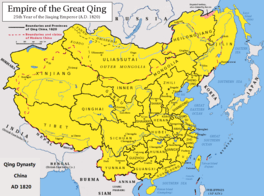Greater China
"Greater China" is the geographic area that shares commercial and cultural ties to the Han Chinese.[1][2][3] The area described by this informal term is not always entirely clear, but it normally encompasses mainland China, Hong Kong, Macau, and Taiwan.[4][5][6] Some analysts may include other overseas Chinese communities throughout the world, notably Singapore, and Malaysia as they may either define the term as "the linkages among the far-flung international Chinese community".[7][8]
| Greater China | |||||||||||||||||||
|---|---|---|---|---|---|---|---|---|---|---|---|---|---|---|---|---|---|---|---|
| Simplified Chinese | 大中华 | ||||||||||||||||||
| Traditional Chinese | 大中華 | ||||||||||||||||||
| |||||||||||||||||||
Usage
Commercial usage
Multinational corporations frequently use the term to name their regional headquarters. For example, P&G uses it to name its regional headquarter in Guangzhou that also operates in Hong Kong and Taipei.[9] Apple uses it for its regional headquarters in Shanghai.[10][11]
Academic usage
Universities among other research institutions such as Columbia University use the term for studies of the region.[12]
Political usage
The term is often used to avoid invoking sensitivities over the political status of Taiwan.[13]
History


The term has been used for a long time, but with differing scope and connotations.
In the 1930s George Cressey used it to refer to the entire Chinese Empire, as opposed to China proper.[14] Usage by the United States on government maps in the 1940s as a political term included territories claimed by the Republic of China that were part of the previous empire, or geographically to refer to topographical features associated with China that may or may not have lain entirely within Chinese political borders.[14]
The concept began to appear again in Chinese-language sources in the late 1970s, referring the growing commercial ties between the mainland and Hong Kong, with the possibility of extending these to Taiwan, with perhaps the first such reference being in a Taiwanese journal Changqiao in 1979.[14]
The English term subsequently re-emerged in the 1980s to refer to the growing economic ties between the regions as well as the possibility of political unification.[14] It is not an institutionalized entity such as the EU or ASEAN. The concept is a generalization to group several markets seen to be closely linked economically and does not imply sovereignty.[13]
Controversy
For some Asians, the term is a reminder of the "Greater East Asia Co-Prosperity Sphere", a euphemism for the region controlled by Imperial Japan during the Second World War.[15]
See also
- Adoption of Chinese literary culture
- Bamboo network
- East Asian cultural sphere
- History of China
- List of tributaries of China
- Nine-dash line
- Sinophone
- Greater India
References
- "Pact row could harm Greater China economic integration: ANZ". Focus Taiwan. 2 April 2014. Retrieved 6 November 2018.
- MTV Channels In Southeast Asia and Greater China To Exclusively Air The Youth Inaugural Ball Archived 2009-05-22 at the Wayback Machine - MTV Asia
- June 1, 2008, Universal Music Group realigns presence in Greater China Archived 2017-12-14 at the Wayback Machine, Television Asia
- William, Yat Wai Lo (2016). "The concept of greater China in higher education: adoptions, dynamics and implications". Comparative Education. 52: 26–43. doi:10.1080/03050068.2015.1125613.
This term can be narrowly defined as referring to a geographic concept that consists of the People's Republic of China, the Republic of China, the Hong Kong Special Administrative Region and the Macau Special Administrative Region, where ethnic Chinese comprise the majority of the population. In this sense, the term is used to describe the ethnic and the associated political, economic and cultural ties among these Chinese societies (Harding 1993; Cheung 2013).
- "Apple overtakes Lenovo in China sales". Financial Times. 18 August 2011. Archived from the original on 27 November 2011. Retrieved 19 November 2011.
- "《路透晚报》4月29日日间新闻摘要(大中华区)". 路透中文网 reuters.
- William, Yat Wai Lo (2016). "The concept of greater China in higher education: adoptions, dynamics and implications". Comparative Education. 52: 26–43. doi:10.1080/03050068.2015.1125613.
However, some analysts see the Greater China concept as a way to summarise ‘the linkages among the fair-flung international Chinese community’, thereby incorporating Singapore and overseas Chinese communities in their usage of the term (Harding 1993, 660; also see Wang 1993).
- Harding, Harry (December 1993). "The Concept of "Greater China": Themes, Variations and Reservations*". The China Quarterly. 136: 660–686. doi:10.1017/S030574100003229X. ISSN 1468-2648.
- "P&G in Greater China". www.pgcareers.com. Retrieved 16 March 2020.
- "Isabel Ge Mahe named Apple's managing director of Greater China". Apple Newsroom. Retrieved 16 March 2020.
- Mickle, Andrew Dowell and Tripp (14 March 2020). "Apple Closes All Its Stores Outside China Over Coronavirus". Wall Street Journal. Retrieved 16 March 2020.
- "Greater China - Weatherhead East Asian Institute". weai.columbia.edu. Retrieved 16 March 2020.
- Aretz, Tilman (2007). The greater China factbook. Taipei: Taiwan Elite Press. ISBN 978-986-7762-97-9. OCLC 264977502. Archived from the original on 2009-01-31.
- Harding, Harry (December 1993). "The Concept of 'Greater China': Themes, Variations and Reservations". The China Quarterly. 136 (136, Special Issue: Greater China): 660–686. doi:10.1017/S030574100003229X.
- Shambaugh, David (December 1993). "Introduction: The Emergence of 'Greater China'". The China Quarterly (136, Special Issue: Greater China): 654.